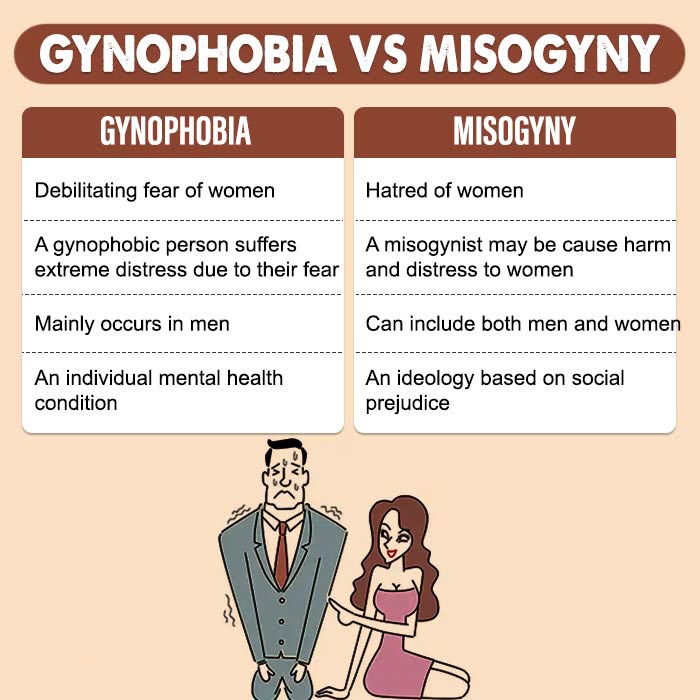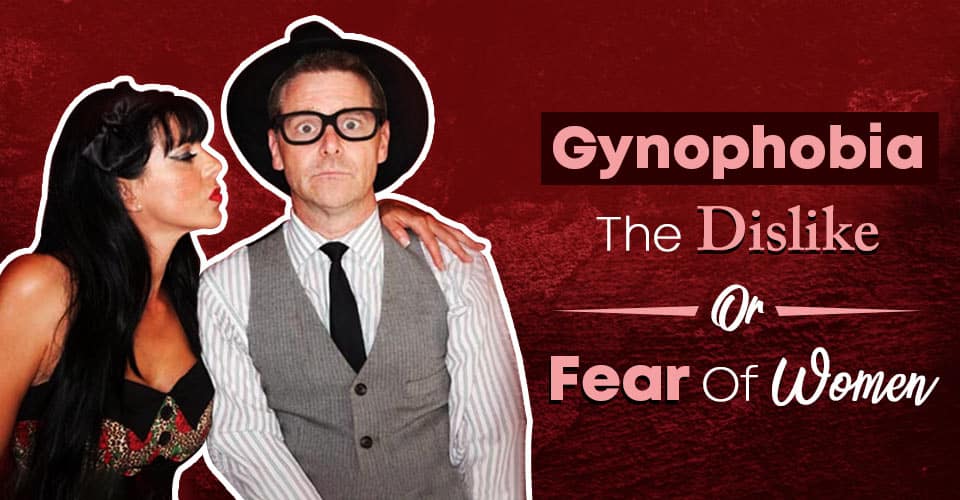Gynophobia is a common anxiety disorder that affects many men around the world. It is characterized by an irrational fear or aversion towards women, leading to avoidance or panic in social situations involving women. This phobia can have significant impacts on personal and professional relationships and may require therapy or treatment to overcome.
What Is Gynophobia?
Gynophobia is an extreme, persistent, and irrational fear of women. Derived from the Greek term gunē (women) and phobos (fear), it is a kind of specific phobia that is also known as gynephobia or feminophobia.
Previously, this condition was known as horror feminae 1 Wortis J. (1993). Heterophobia: horror feminae and horror viri. Biological psychiatry, 34(8), 505–506. https://doi.org/10.1016/0006-3223(93)90191-f . It is believed that the term gynophobia was originally used to describe the anxiety and fear men experience upon being emasculated and humiliated by women.
As emasculation often makes most men feel mentally and emotionally vulnerable by depriving them of their ‘masculinity’, it can often lead to the development of a fear of or aversion to women.
Women can also be affected by gynophobia. Gynophobics are not only afraid of women in general, they can also be scared of their own female family members like mothers and sisters, as well as potential romantic partners.
People with this condition may avoid interacting with women and being in relationships with them, as their crippling fear often leads to high levels of anxiety and sometimes even panic attacks. Some associated phobias include venustraphobia or caligynephobia, or the fear of beautiful women and genophobia (the fear of sexual intercourse).
This fear may develop right from childhood and cause problems in later adult life if not resolved in time.
Gynophobia vs Misogyny
Gynophobia must not be confused with misogyny although the two may appear to be related. Misogyny is a hatred for or prejudice against women. While misogyny is primarily a social prejudice that is learnt through conditioning and observation, gynophobia is a type of anxiety disorder.

Read More About Phobia Here
Symptoms Of Gynophobia
Gynophobia symptoms may present both physiologically and psychologically.
Physical symptoms
On encountering women in any manner, people with gynophobia may experience the following symptoms
- Trembling or shaking
- Sweating
- Shortness of breath
- Rapid heartbeat
- Tightness in the chest
- Dizziness and nausea
- Upset stomach
- Dry mouth
Psychological symptoms
- An intense discomfort and fear of seeing/ hearing/ interacting with women
- The urge to escape any situation where there are women
- Fear of losing control or dying
- Purposefully avoiding women
In children, gynophobia may manifest through crying, clinging, or refusal to leave a male family member’s support and comfort.
What Causes Gynophobia?
The exact cause for the development of an irrational and extreme fear of women, who are usually not dangerous, is not clearly known. However, like most specific phobias, both genetics and environment can act as possible risk factors for gynophobia.
Here are some of the most probable gynophobia causes.
1. Genetic factors
People with a family history 2 Loken, E. K., Hettema, J. M., Aggen, S. H., & Kendler, K. S. (2014). The structure of genetic and environmental risk factors for fears and phobias. Psychological medicine, 44(11), 2375–2384. https://doi.org/10.1017/S0033291713003012 of phobias or anxiety disorders are more likely to develop specific phobias such as the fear of women. Genetics play a crucial role when it comes to fears and phobias 3 Lichtenstein, P., & Annas, P. (2000). Heritability and prevalence of specific fears and phobias in childhood. Journal of child psychology and psychiatry, and allied disciplines, 41(7), 927–937. .
2. Environmental factors
Environmental factors 4 Loken, E. K., Hettema, J. M., Aggen, S. H., & Kendler, K. S. (2014). The structure of genetic and environmental risk factors for fears and phobias. Psychological medicine, 44(11), 2375–2384. https://doi.org/10.1017/S0033291713003012 also play a contributing role in gynophobia. Traumatic experiences with women are one of the major factors for the onset of a fear of women. For instance,
- Mental, physical, or sexual abuse
- Abandonment or rejection
- Infidelity
- Public humiliation, etc.
Moreover, scary stories about witches may also trigger the development of this phobia.
3. Other factors
Apart from genetics and environment, our brain structure and personality may also influence the development of such a phobia. Someone who is more inhibited, sensitive or ha may be more likely to be afraid of women.
Diagnosing Gynophobia
Gynophobia can be diagnosed as a specific phobia, according to the Diagnostic and Statistical Manual of Mental Disorders (DSM-5 5 Substance Abuse and Mental Health Services Administration. (2016, June). Table 3.11, DSM-IV to DSM-5 Specific Phobia Comparison. Nih.gov; Substance Abuse and Mental Health Services Administration (US). Available from: https://www.ncbi.nlm.nih.gov/books/NBK519704/table/ch3.t11/ ). To be diagnosed with a specific phobia, a person must be experiencing this fear for a period of six months or more and it must cause them clinically significant distress and interfere with their day-to-day functioning.
There are no particular tests that can assess gynophobia. However, a mental health professional generally takes a detailed history of the symptoms, a person’s premorbid personality, and may ask about their family too, before arriving at a diagnosis.
How To Treat Gynophobia?
Although the fear of women may not appear like a damaging condition to most of us, gynophobia can become a serious obstacle in the life of a person suffering from it. This is why it is crucial for people with gynophobia to seek professional help. Gynophobia treatment can involve either therapy or in extreme cases, even medication.
Some methods of treatment for gynophobia are discussed below.
1. Exposure therapy
Exposure therapy 6 Sars, D., & van Minnen, A. (2015). On the use of exposure therapy in the treatment of anxiety disorders: a survey among cognitive behavioural therapists in the Netherlands. BMC psychology, 3(1), 26. https://doi.org/10.1186/s40359-015-0083-2 is an effective way to change a person’s phobic reaction to women. By repeated and gradual exposure to images and media related to women in a controlled setting, a therapist tries to desensitize the patient to their fear and enable them to develop positive coping mechanisms.
As they become increasingly desensitized, the therapist will guide them to interact with women in real life to gain control over their fear and themselves.
Exposure therapy helps to modify the thoughts, emotions, and reactions of the patient towards women in a step-by-step and incremental manner.
2. Cognitive behavioral therapy (CBT)
CBT 7 Priyamvada, R., Kumari, S., Prakash, J., & Chaudhury, S. (2009). Cognitive behavioral therapy in the treatment of social phobia. Industrial psychiatry journal, 18(1), 60–63. https://doi.org/10.4103/0972-6748.57863 addresses the negative thoughts and dysfunctional beliefs underlying gynophobia and systematically modifies them to replace them with more adaptive thoughts and behaviors.
CBT makes the sufferers feel more confident about themselves and allows them to master their thoughts and behaviors instead of feeling anxious and overwhelmed.
Read More About CBT Here
3. Medications
Although there are no specific medications for the treatment of gynophobia, certain medicines can be used to relieve anxiety, panic attacks and other symptoms associated with this condition.
Medications can prove to be especially effective when used along with therapy. However, medications must be taken only during the initial phase of the treatment process to enhance the efficiency of therapy and improve the effectiveness of the recovery process. It may also be used for a short-term period on an infrequent basis.
Presently, the following medications are used in the treatment of gynophobia:
- Beta-blockers help to manage the physical symptoms of anxiety
- Sedatives, like benzodiazepines, help to reduce severe anxiety
- Antidepressants, like selective serotonin reuptake inhibitors (SSRIs), help to prevent panic attacks
However, it should be remembered that medication only helps in relieving the symptoms associated with this phobia and not the actual condition or the underlying causes.
Read More About Antidepressants Here
How To Overcome Gynophobia?
Although experts are still unsure of how to prevent gynophobia, some self-help strategies may be adopted for coping with gynophobia and improving one’s day-to-day functioning:
- Try to read and learn more about gynophobia so you can understand your behavior better.
- Practice relaxation techniques such as deep breathing, and progressive muscle relaxation to deal with the physical symptoms of stress.
- Start by reading positive things about women (in biographies or fictional women-centric stories) or watching videos/ short films with positive female characters.
- Maintain a journal or confide in a trusted friend to express your feelings honestly.
- Talk to people who are in healthy relationships with women or have several friends and acquaintances who are women.
Takeaway
Gynophobia can have a serious impact on a person’s life. Not only can it affect their personal life and relationships, but can also lead to mood disorders like depression, social isolation, substance abuse and even suicidal tendencies.
This is why it is important to speak with a trusted loved one and seek professional help. Treatment can significantly help people in overcoming gynophobia and living a normal, social, and happy life.
At A Glance
- Gynophobia is an abnormal fear of women that can make an individual feel overwhelmed and also affect their daily life.
- Not only men, but women can also be affected by gynophobia.
- While misogyny is primarily a socio-cultural attitude that can be damaging, gynophobia is a phobic response that can lead to severe anxiety in the sufferer.
- It affects the sufferer’s personal life and relationships.
- It can also lead to mood disorders like depression, social isolation, substance abuse and even suicidal tendencies.
- A mental health professional may recommend therapy, medication or a combination of both, after analyzing the sufferer’s medical and psychiatric histories.
Frequently Asked Questions (FAQs)
1. How common is gynophobia?
Gynophobia is not a very common condition in comparison to other specific phobias.
2. Is gynophobia a mental illness?
Gynophobia can be considered a specific phobia, which is classified as a disorder in the Diagnostic and Statistical Manual of Mental Disorders.
3. Can a girl have gynophobia?
Yes, it is possible for a girl to have gynophobia. Gynophobia can affect individuals of any gender and refers to a fear or aversion to women or femininity or the feminine aspects of oneself.















